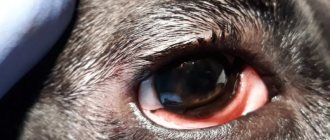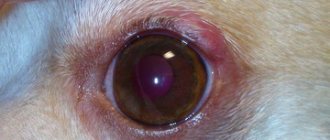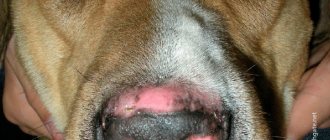Bronchitis in dogs is an inflammatory respiratory disease. The symptoms of the pathology are obvious, but similar to other problems of the respiratory system. A veterinarian must determine the disease, identify its causes and prescribe treatment. Bronchitis is dangerous because advanced inflammation can spread to the lungs, leading to pneumonia and more severe consequences.
The dog's respiratory system consists of the following sections: nose, sinuses, larynx, trachea, bronchi (bronchial tree), lungs and diaphragm. Each structure has its own irreplaceable function. Pathology in any organ can lead to a significant deterioration in the pet’s quality of life due to impaired oxygen supply to the tissues.
What is bronchitis, its types in animals
Bronchitis is the development of an inflammatory process in the mucous layer of the bronchi in a dog. The pathology is characterized by sudden bouts of coughing and nasal discharge.
The inner layer of the bronchi secretes mucus throughout life. One of its main functions is protective. Mucus helps get rid of foreign objects and also contains a lot of proteins. This composition creates a bactericidal barrier and does not allow pathogens to penetrate into the respiratory tract. With the development of bronchitis, the mucous layer becomes inflamed, the protective function is disrupted and the bronchi become susceptible to the penetration of pathogenic microorganisms. The process is accompanied by the accumulation of exudate, as a result of which the lumen of the bronchi narrows and gas exchange is greatly reduced.
By origin, the pathology is:
- Primary, when inflammation develops as an independent disease.
- Secondary, when bronchitis is a symptom or complication of the underlying disease.
According to the nature of the course, inflammation is divided into:
- Acute - lasts less than 10 days, symptoms are obvious. If a dog with this form receives inadequate treatment, bronchitis becomes chronic.
- Chronic - pathology lasts more than 10 days. The pet initially shows improvement, but then the symptoms worsen again and recur periodically.
In veterinary medicine, bronchitis is also distinguished by the type of inflammation:
- serous;
- catarrhal;
- purulent;
- putrefactive;
- fibrinous;
- hemorrhagic.
Reasons for the development of bronchitis
Veterinary practice shows that the following causes most often lead to inflammation of the bronchi:
- Hypothermia. A cold due to long walks of the animal in the cold, in the rain, in bad weather is the main cause of the development of primary bronchitis in dogs.
Swimming a pet in a cold body of water or water procedures in an unheated room often leads to illness. Representatives of long-haired breeds can get sick due to poorly dried wool after bathing.
Most often, smooth-haired and dwarf dog breeds with a poorly developed heat exchange system are susceptible to the inflammatory process in the bronchi. Veterinary experts note that representatives of brachycephalic breeds suffer from bronchitis more often than pets with a normally developed skull. This is due to the peculiarities of the anatomical structure of the nasal passages.
- Unsatisfactory living conditions. Prolonged stay in cold and damp rooms, placing the dog on a cold floor without bedding often leads to the development of respiratory diseases.
- Errors in feeding. A lack of complete proteins, vitamins and minerals in the diet reduces the local protective functions of the bronchial epithelium. Vitamin A and ascorbic acid are the most important vitamins for cellular immunity. When they are deficient in the body, the mucous membrane becomes permeable to pathogenic viruses, bacteria and fungi.
- Inhalation of dust, toxic fumes, and tobacco smoke. Containing caustic substances, harmful smoke leads to irritation and hyperemia of the bronchial mucosa, which is accompanied by the development of an inflammatory reaction.
- Allergy. Its presence in a dog on food components, medications, household pesticides, dust, and pollen leads to hyperemia, the development of edema and an inflammatory reaction on the part of the bronchial mucosa.
- The cause of the development of secondary bronchitis in dogs is pathogens of infectious diseases. Distemper of carnivores, adenovirus infection, viral tracheitis, parvovirus enteritis are the main causes of infectious inflammation of the bronchi. Pathogenic microorganisms enter the respiratory tract through the blood or lymph.
- Non-communicable pathologies of the respiratory system. Tracheitis, laryngitis, pneumonia of various origins, pleurisy.
- The cause of bronchitis in dogs can be helminthic infestations. Larvae or adult parasites often migrate from internal organs to the respiratory tract and enter large or small bronchi. By mechanically irritating the delicate mucous membrane of the organ, helminths provoke the development of an inflammatory reaction.
Veterinary experts note that elderly pets over 6 years of age, as well as dogs weakened by the primary disease, are susceptible to diseases of the respiratory system. Stress in animals and a weak immune system can provoke the development of the disease. If your pet has dental problems, there is a risk of viruses and microbes from the pathological focus entering the respiratory system.
Reasons why a dog can get sick
The following factors can lead to bronchitis in a dog:
- Pathogenic microorganisms of various natures: viral (canine distemper, parvovirus, herpes, adenovirus, influenza, parainfluenza), bacterial (mycoplasmosis, chlamydia, bordetellosis, tuberculosis), fungal.
- Entry of a foreign object into the respiratory tract.
- Violation of the pet's keeping conditions (constant high humidity, poor ventilation).
- Hypothermia (swimming in a cold body of water, long walks for pets of short-haired breeds at low temperatures).
- Inhalation of chemical or allergenic substances that irritate the mucous membranes: gases, smoke, household chemicals, pollen, dust. When exposed to such agents, eosinophilic bronchitis develops.
- Concomitant diseases of the respiratory system.
- Parasitic diseases.
- Neoplasms.
Associated causes that can trigger the development of inflammation:
- Age. If it is infectious, puppies under one year of age are more likely to get sick.
- Crowded housing of animals in nurseries or shelters.
- Almost any form of bronchitis is complicated by a bacterial infection 5-7 days after the onset of inflammation.
- Lack of vaccination.
- Breed characteristics (brachycephalic dogs, representatives of miniature breeds, as well as hunting breeds are more susceptible to the disease).
Diagnostics
To make an accurate diagnosis, the veterinarian needs to provide as much information as possible about the conditions of detention, the dog’s feeding habits, and contacts with other animals. After this, the respiratory tract is examined, the bronchi and lungs are listened to. To determine pathogenic microflora, a smear is taken from the larynx. In some cases, endoscopic examination of the respiratory system is required.
It is necessary to differentiate bronchitis in dogs from other infectious and parasitic diseases. Therefore, a general blood test, bacterial culture, and x-ray may be additionally prescribed.
Symptoms of bronchitis in dogs
Clinical signs of bronchitis in dogs may include:
- Refusal to eat.
- General depressed state (the pet lies all the time, refuses favorite games, reluctantly agrees to go for a walk).
- Gradual exhaustion.
- Rhinitis (runny nose) develops, and the discharge may be clear, yellow, green, or brownish. The discharge can be of various types, symmetrical or one-sided, with or without odor.
- Sneezing.
- Cough (the first 3-4 are dry, then gradually replaced by wet cough).
- When breathing, wheezing is heard.
- Often the animal has an unnatural body position: the pet cannot lie down.
- Shortness of breath appears - difficulty breathing, which occurs due to a lack of oxygen metabolism. Characterized by changes in inhalation and exhalation.
- Breathing becomes abdominal type (normally it should be thoraco-abdominal).
- If bronchitis is viral in nature, the animal also experiences diarrhea (black, foul-smelling), vomiting, discharge from the eyes, and elevated body temperature.
Mortality from the disease is low when it comes to primary bronchitis. In young animals, death occurs due to the viral nature of the pathology.
Danger of bronchitis
Without proper treatment, bronchitis easily becomes chronic. This species is very difficult to treat and remains with the pet forever, either disappearing or appearing again. The slightest factor instantly provokes the disease, weakening the pet each time. The most advanced degree of the disease on examination is manifested:
- emphysema;
- bronchopneumonia;
- severe shortness of breath;
- exhaustion.
These companions of a severe form of the disease entail an unfavorable prognosis, and, as they progress, most often lead to death, provoking heart and pulmonary failure.
Video - About coughing in dogs
How to determine bronchitis in a dog?
Only a veterinarian can make an accurate diagnosis and establish the cause of inflammation. To do this, the doctor conducts a general examination and a number of studies:
- First of all, the veterinarian collects information about the dog: how long has it been sick, whether vaccinations have been carried out, what other symptoms there are, what kind of food the pet receives.
- Breathing assessment: frequency, depth, rhythm, presence of shortness of breath.
- Establishing the type of breathing: thoracic, abdominal, thoraco-abdominal.
- Presence of cough (without this symptom a latent chronic form of bronchitis is possible).
- Auscultation (will reveal wheezing, cardiac dysfunction).
- Thermometry.
- Blood tests (general clinical and biochemical).
- X-ray (the image evaluates the bronchial pattern, position of the lungs, and the presence of tumors).
- If necessary, bronchoalveolar lavage and bronchoscopy are performed to take swabs.
- Diagnosis of viral diseases: PCR, ELISA, serological studies.
Types, forms and symptoms
There are several forms of bronchitis in dogs:
- acute – occurs with infectious lesions of the bronchi, lasts about 2 weeks,
- chronic – develops as a result of advanced respiratory tract infection or prolonged exposure to negative factors,
- allergic – reaction to the influence of an allergen on the bronchi.
The main symptom of bronchitis is cough. At first it is dry, but after a few days it becomes productive. In acute bronchitis, cough is accompanied by other symptoms:
- noisy breathing with wheezing,
- runny nose,
- rapid pulse,
- heat,
- the urge to vomit due to a strong cough,
- pallor and cyanosis of mucous membranes,
- loss of appetite.
Characteristic signs of chronic bronchitis:
- persistent cough for more than 2 months,
- dyspnea,
- cyanosis of mucous membranes,
- hoarse breathing,
- increased fatigue.
On a note! Chronic bronchitis develops gradually. The inflammatory reaction is less pronounced than in the acute form. Over time, the mucosal epithelium is replaced by connective tissue. The contractile function of the bronchi decreases, the airways and alveoli expand, and the working volume of the lungs decreases. In the chronic course of inflammation, periods of slight deterioration alternate with a normal state. The cough often occurs in the morning, after sleep. The chronic course gradually progresses; the pet cannot be completely cured.
Treatment of bronchitis in dogs
Treatment of bronchitis in dogs can be carried out at home, strictly following all doctor’s prescriptions. In a familiar environment, the animal does not experience stress, which speeds up the healing process. The pet is kept in a warm room and goes out for walks for a short time. Inpatient treatment is carried out for severe secondary bronchitis. In the clinic, doctors monitor the dog’s condition, blood counts and breathing, and restore fluid loss.
The elevated temperature is not reduced until a certain point (if possible to 40.1 - 40.6 ° C). The body develops this defense mechanism to fight infection.
In acute cases, symptomatic therapy is carried out. The duration of treatment depends on the severity of the process and the animal’s immunity. If there is nasal discharge, it should be carefully removed as it accumulates.
Antibiotics are indicated for obvious symptoms of bronchitis in a dog of a bacterial nature (lethargy, refusal to eat, nasal discharge). If, after using the first and second choice drugs, the animal does not improve, a BAC culture is performed. Otherwise, bacteria develop resistance to drugs, bronchitis becomes chronic, and it will be more difficult to cure this form in a dog. It is important to find the exact cause of the disease and eliminate it.
If necessary, the pet is prescribed inhalations with saline solution 3-4 times a day. This procedure facilitates the separation of sputum and makes it easier for the animal to breathe. Small dogs are easier to manipulate than large dogs. It is enough to put them in a carrier and throw a blanket on top. Then the tube from the nebulizer is brought to the grille and the pet is allowed to breathe in the vapor. For large animals, the device is placed directly on the nose.
Examples of medications that are used to treat bronchitis in dogs:
| Nature of action of the drug | Prescribed funds |
| Antibacterial drugs |
|
| Expectorants | Bromhexine, ACC, Ambroxol, they facilitate sputum production |
| Immunomodulators | Roncoleukin, Ribotan, Imunofan (for viral nature of inflammation) |
| Solutions for thinning sputum | Saline solution, mineral water (used in the form of inhalations) |
Expert opinion
Kuzmenko Olga Olegovna
Information about the expert
Ask a Question
In case of an allergic nature, antihistamines are prescribed during the period of exacerbation of the condition. The main measure is to prevent the animal from coming into contact with the irritating substance.
Pet treatment
Therapy for bronchitis, as a rule, does not require placing the furry patient in a specialized clinic. At home, the pet is primarily provided with peace and warmth. A sick animal should wear a warm sweater or overalls. Walking in inclement weather is kept to a minimum.
In the complex treatment of bronchitis, the veterinarian usually includes expectorants and antispasmodics. In order to thin the sputum and facilitate its removal, the dog is prescribed Bromhexine, Mucaltin, Lazolvan, Bronholitin, Ambroxol. Thermopsis, licorice root in the form of syrup, and sodium bicarbonate have a good expectorant effect.
Among traditional medicines, on the recommendation of a veterinarian, you can use marshmallow, coltsfoot, and thyme. Eufillin, which has a bronchodilator effect, is used subcutaneously.
Bronchitis is often accompanied by rhinitis. To relieve the condition, the pet is prescribed nasal drops - Anandin, Tsiprovet, Pinosol.
If the etiology of the disease is parasitic, the animal is prescribed anthelmintic drugs. The drug and dosage are determined by a veterinarian based on the results of an examination of feces or bronchial swabs.
If the cause of bronchitis is an allergy, the animal is prescribed antihistamines - Suprastin, Diphenhydramine, Tavegil. The allergic form of the disease is successfully treated with corticosteroid drugs, for example, Prednisolone, Dexafort.
At home, it is useful for a sick pet to use thermal physiotherapy, for example, warming it up with Sollux lamps. Massage and tapping of the animal's chest help liquefy and remove mucus. Inhalations of warm steam based on decoctions of medicinal herbs are also useful.
For information on the causes, symptoms and treatment of bronchitis in dogs, watch this video:
How to feed your pet when sick
During illness, it is important for the animal to stimulate its appetite. If the nose is clogged, the dog cannot smell, which reduces the quality of feeding. The pet is offered wet food; if necessary, it is heated (so that the smell is more pronounced). If there is no appetite, the animal is treated to its favorite delicacies (provided that these are not fried or smoked foods).
If the desire to eat does not arise within 3 days, the pet is force-fed. Liquid, softened food is offered by hand or introduced into the mouth from a syringe. If you abstain from food for a longer period of time in a veterinary clinic, the procedure is carried out through a tube, or parenteral nutrition is used (solutions, amino acids and the necessary elements to maintain vital functions are administered intravenously).
During the recovery period, the dog's diet should contain easily digestible ingredients. The feed is slightly warmed up before feeding. Vitamin supplements are administered in consultation with the doctor.
Clinical picture
The main symptom of acute bronchitis is a cough. At first dry, “barking”, after 3-4 days it gives way to wet. The cough is so strong and debilitating that it is often accompanied by vomiting or retching. The puppy is wheezing and breathing noisily due to rhinitis. There is a risk of hypoxia; this phenomenon is indicated by a blue discoloration of the tongue and gums.
The pulse quickens, the temperature may rise, but in most cases, acute bronchitis occurs without hyperthermia. The dog becomes lethargic, apathetic, refuses to eat, and therefore may lose weight.
The chronic stage of the disease is a long-term inflammatory pathology of the bronchi and occurs if acute bronchitis cannot be cured within 2 months. In dogs, this disease progresses very slowly and is not 100% curable.
Symptoms of bronchitis in dogs (chronic stage):
- cough for 2 months;
- difficulty breathing, wheezing;
- dyspnea;
- pallor or blueness of the skin and mucous membranes;
- lack of appetite;
- chronic fatigue.
At this stage, the cough is usually dry, but during an exacerbation, sputum appears. If left untreated, the animal develops chronic obstructive pulmonary disease (COPD).
Prevention measures
- Conduct annual routine vaccination against viral infections.
- Give anti-helminth medications once every 3-4 months.
- In the warm season, carry out treatment against ectoparasites in a timely manner.
- Balanced diet. Selecting good quality commercial feed or selecting ingredients to create a complete homemade diet.
- Provide optimal conditions for keeping the pet (monitor the level of humidity in the room, temperature conditions).
- Avoid contact of the dog with irritating and harmful gases and chemicals.
- In the cold season, representatives of smooth-haired breeds wear special insulated suits for walks.
- When kept in a shelter or nursery, sick and newly arrived animals are isolated for the entire period of treatment or for the duration of quarantine. The premises are periodically disinfected with special solutions.
- When kept in enclosures in winter, food and drinking water are heated.
Bronchitis in dogs can develop as an independent disease or be a concomitant symptom of serious pathologies. In any case, the pet’s quality of life decreases due to disruption of gas exchange processes in organs and tissues. After a series of necessary studies, the veterinarian prescribes treatment, which must be carried out in full to prevent the pathology from becoming chronic.
Treatment methods
At the first signs of a respiratory disease, there is no need to waste time; it is important to immediately consult a doctor. Self-medication in such cases is not recommended. The approach to treatment must be comprehensive. Therapy includes eliminating the root cause, relieving symptoms, and strengthening the body's defenses.
General rules
In order for your dog to recover faster, it needs to be provided with proper care during treatment:
- keep in a warm room with a humidity of 55-60%;
- ventilate the home more often;
- do not let outside in cold weather, short walks are allowed if the weather is warm and windless;
- wrap your neck and chest well, or apply a heating pad to warm the bronchi;
- Give the animal a lot to drink; you can add decoctions of chamomile, anise, calendula, and St. John's wort to the water.
Antibiotics
Antibiotics for dogs can be prescribed after receiving the results of a bacterial culture and sensitivity test. But the analysis takes a long time, and with bronchitis, lost time for treatment can lead to complications.
More often it is necessary to resort to the use of broad-spectrum antibiotics:
- Amoxicillin;
- Ceftriaxone;
- Streptomycin;
- Erythromycin.
If bacteria are resistant to drugs, tetracycline antibiotics are prescribed. In severe cases, Tetracycline is administered intramuscularly in combination with Levomycetin and Kanamycin. Enroxil (0.1 ml/kg) is also effective for respiratory tract infections. It is administered subcutaneously or given in the form of tablets (they taste like meat) once a day for 5 days.
Symptomatic treatment
To relieve cough during bronchitis, it is recommended to take mucolytics and antitussives. For a wet cough, the dog is given:
- Bromhexine;
- ACC;
- Bronholitin.
Bronchial spasms can be eliminated using special means:
- Eufillin;
- Ephedrine.
Coltsfoot has good expectorant properties. Its leaves can be added to food at a rate of 2-5 g per day. Thermopsis tincture is also useful. It is infused in boiling water (1:200), and the animal is given 1 spoon per day.
If bronchitis is accompanied by a runny nose, vasoconstrictor drops that people use cannot be used by dogs. Suitable for your pet:
- Anandin;
- Maxidin.
Strengthening the immune system
Inflammation of the bronchi often occurs against the background of a weakening of the body's defenses. In order for your dog to recover faster and overcome the disease, you need to strengthen its immunity.
Immunomodulators can be used:
- Imunofan;
- Glycopene;
- Gamavit.
Warming procedures and physiotherapy (infraruuge, solux, UHF) effectively stimulate the body to fight infection. The animal also needs additional vitamins A, B, C.
Nutrition correction
While the dog is sick, its diet needs to be adjusted. Food must be kept warm. Products should be easily digestible and digestible.
It is recommended to include in the diet:
- rice, oatmeal;
- ground boiled meat (veal, chicken);
- warm dairy products;
- boiled vegetables.
It is better to avoid dry food during treatment. They irritate the mucous membrane of the oropharynx and can cause discomfort.
How and how to treat a pinched nerve in a dog? View a selection of effective treatment options.
Instructions for using the cardiotropic drug Vetmedin for small breed dogs are described in this article.
On the page https://melkiesobaki.com/veterinariya/zabolevaniya/drugie/pochechnaya-nedostatochnost.html you can learn about the signs, symptoms and treatment of acute kidney failure in dogs.











